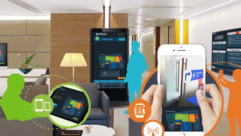
The New Paradigm of Digital Signage
Sep 21, 2010 3:04 PM,
By Cynthia Wisehart
This week, someone described digital signage to me—not for the first time, I’m sure—as the “multimedia” of this century. Pick a meaning, any meaning.
This same colleague said that if you Google digital signage providers, the search returns more than 400 entries: integrators, content creators, and hardware providers selling everything from tiny single-display appliances to vast interconnected systems that can double as a LAN and make you taller.
The challenge in describing digital signage parallels something we struggle with in publishing: how to describe a new paradigm in terms of the old. In our process, we can confuse “print”—a distribution method—with the information that travels along that distribution path. But more importantly, print also describes a particular relationship that is defined by the physical nature of the distribution method. Print cannot be interactive, at least not in realtime.
Likewise, signs are a presentation, a guess, a one-sided conversation. Digital signage sounds like a way to describe signs that move and change, but in describing them based on the physical characteristics of what is familiar, we miss the way that digital signage is so materially different.
Digital signage has more in common with the Internet or your smartphone than with billboards or posters. Yes, digital signage can take on the form factor of those familiar displays. But to really understand the value proposition for digital signage—and to design the systems that will support it—it is important to understand that digital signage is, above all else, interactive. It is an AV communications system that can range from simple to complex. And like most modern communications systems, it has the potential to be customized in realtime, to be personalized, to be monitored, to be driven by databases, behavior or feedback, or password-based access.
Sometimes digital signage systems will resemble signage, but even then—in retail, hospitality, or transportation settings—it will respond to environment and to use patterns. How an end-user plans to use the system to communicate and to take feedback will drive most of what is under the hood of the system.
What this means for integrators is that the sales process for digital signage—and, to an extent, the installation process—is highly consultative, and likely collaborative with disciplines we are not used to working with. This means fellow technology specialists such as IT engineers, but also content stakeholders such as marketing and HR professionals who understand the use case and ROI that will drive the system purchase.
It will take time and effort for our industry to come to define and execute digital signage, whatever that means. But one place to start this month is our webcast “Digital Signage Systems Design.” In this webcast, we’ll look at the types of content that drive digital signage buys for the end-user and the technical implications that each of these content types have. Watch your email for an invitation (it’s free) or go to svconline.com/webcasts to sign up.










